Wild plums: hidden in plain sight but plum worth hunting for!
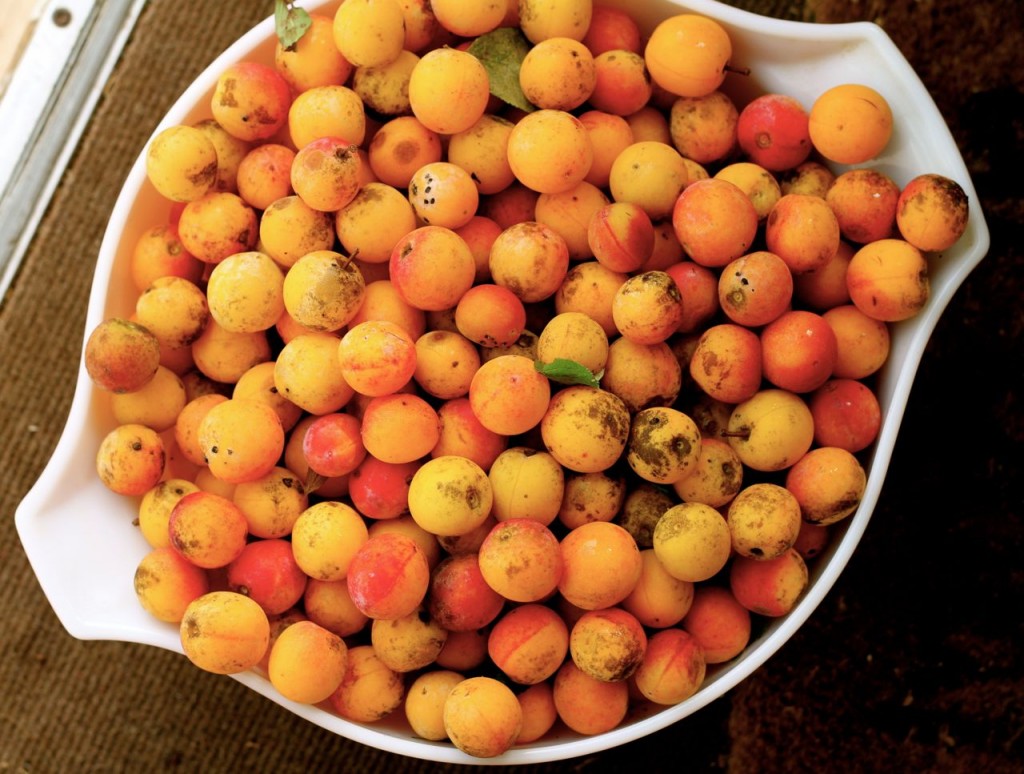
I have never picked so many wild plums in my life as I have this year, Gentle Reader. It must be a bumper crop year for prunus americanas here in Nebraska. Even better, I’ve picked so many different varieties. It has been delightful! Why, within a mile of my house (and I doubt if this is atypical in the Midwest) I’ve found four distinct varieties: one that is golden when ripe, and round; one that is a rosy red and also round; and a variety that is more of an olive shape and turns a deep magenta when ripe.
Oh! Wait, also I found some precious “cherry plums” that look like red ripe cherries. This was a particularly serendipitous find, since I’ve never even seen these before and my friend Gene and my Mom didn’t even know what they were. And they know nearly everything about wild foods, I think.
Have you ever indulged in wild plum picking? I say “indulged” because the wild plums are ripening during late summer and early fall, when the garden is begging to be harvested and there is plenty of work at home to occupy one.
Usually, I keep my head down and do the work at home, during harvest season. I can tomatoes and make salsa and dig potatoes and freeze pistou and all the rest, and when I pass the wild plum thickets on the road, I feel pangs of regret. This year is different. I’m making the time to stop and check out the thickets near my place. When Mack and I go on bike rides, I grab a couple of bags and stuff them in my pocket, just in case. When I see thickets full of fruit, I make a point to ask the farmer if I can pick it.
The reaction I’ve gotten so far: “There are wild plums out there? Sure, pick ’em, I don’t care.”
I just love the farmers around here. They are good sorts, and exceedingly generous. Generous with treasure. They are so busy getting the corn and the beans in, and moving the pigs around, that they don’t have time to fuss around with all the wild goodness that comes up in the ditches (happily, for me).
Wild plums are small but they are packed with flavor. I just love the taste, and the way they make my jaws ache just a bit when I eat them. They are the opposite of bland. If you’re bored with the plum offerings at your supermarket, do make the effort to seek out wild plums. They are special. Plum special.
Here’s what I’ve learned this fall, in making the time to actually stop and pick wild plums, rather than just pass wistfully by:
- There are many, many varieties of wild plums that ripen at different times in the growing season.
- Each variety has its own type of taste, shape, and peculiar beauty.
- Plum thickets are brutal, with little spikes that will make a mess of your arms. Folks will wonder what the heck you’ve been tangling with, unless you do something smart like wear long sleeves when you go to pick. Bear? Monkey with long fingernails? Giant spiders? Opossum mama defending its young? What has scratched your arms up so badly, that is what they will ask you.
- A bush full of fruit won’t ripen all at once, meaning that you can go back once or twice a week to pick, if you want to get as much fruit as possible, over the course of a month or more.
- Wild plums are hidden everywhere: it’s hard to see the fruit from the road, as you are driving past. You need to stop and investigate. 🙂
- Investigating is fun.
- Investigating can be dangerous: where wild plums thrive, wild vines and plants also grow that want to hurt you: poison ivy. Nettles. Thistles. Et al. Mean, villainous plants intent on adding to your miseries.
- One thing you might ponder as you pick, is this: “plum ripe,” “plum ready,” “plum tired”: why are there so many descriptive phrases using the word “plum”? Or is it only my family that uses these?
- If you eat too many plums while picking, later you might have a bellyache. 🙁 I hear. . . ouch . . .
- One can quickly become obsessed with gathering wild treasure, to the exclusion of housework. 🙂 Or other things that may prove suddenly odious: paying bills on time. Dusting. Mowing the grass. Cleaning out the ‘fridge, for pete’s sake.
- It’s best to pick wild plums as they are turning color, and then let them ripen completely in your ‘fridge. If you wait until they are “plum ripe” (see how handy?) to pick them, the ones that are still in the bush (most will already be on the ground) will drop, at the slightest touch, to the long grass at your feet and you won’t be able to find them. And you’ll be plum disappointed, baby. Plum baby. Plum silly.
- It’s fun to be on Instagram.
That last one is not really plum-related, or is it? . . . check out my Instagram feed!
Now for the photos: I’ve been taking a lot of them, because I figure I’m not the only one to be plum entranced with these jewel-like wild fruits.
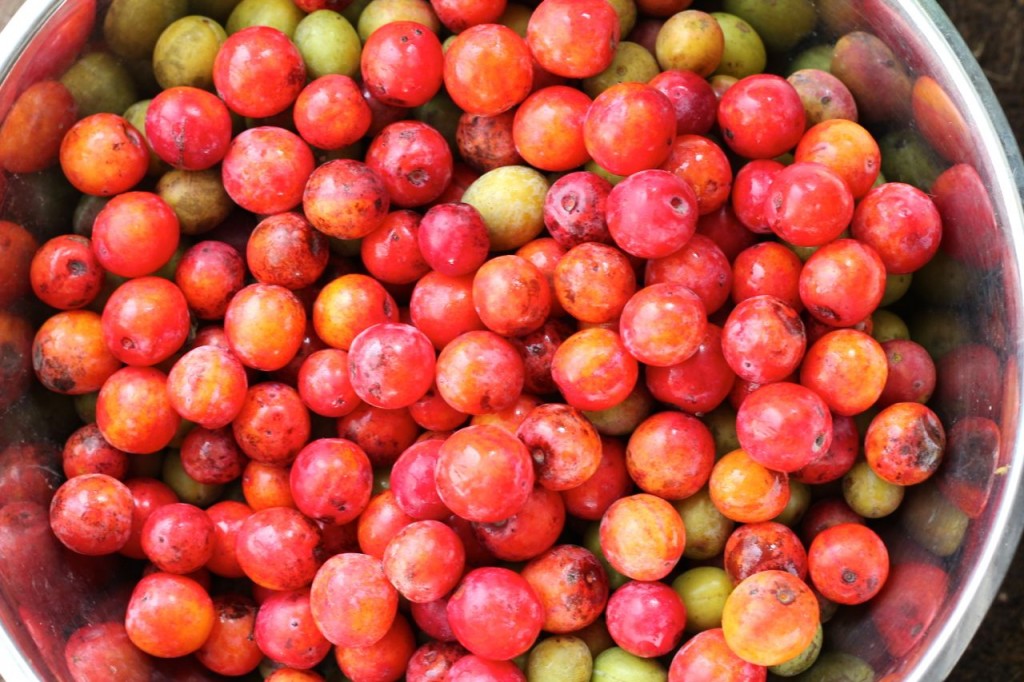
Is there any question that God designed these to be attractive enough for us to check them out? Have you ever seen anything prettier, really? Don’tcha just wanna try one?
Wild plums bushes can get quite large. If you give them a good shake, you’ll be rained on with ripe plums. The unripe ones will hold fast, however.
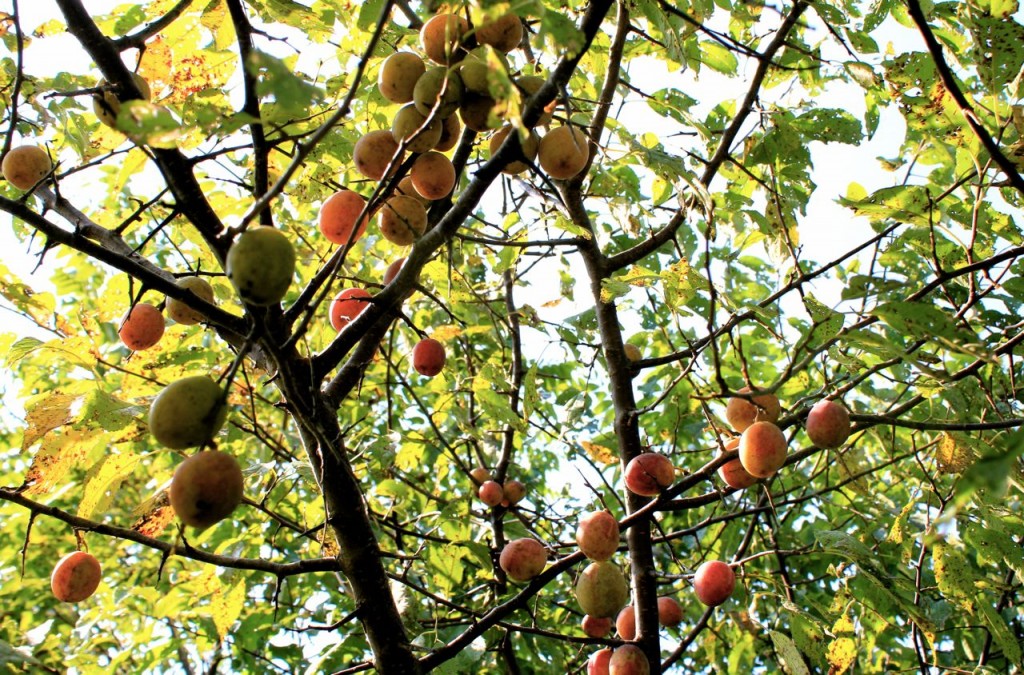
These were towering above me, probably 10 or 15 feet tall!
Plum thickets hide their fruit well. You’d probably never suspect that the bushes in the photo below yielded enough fruit to make me nearly crash my bike on the way home. I was that burdened with plum weight.
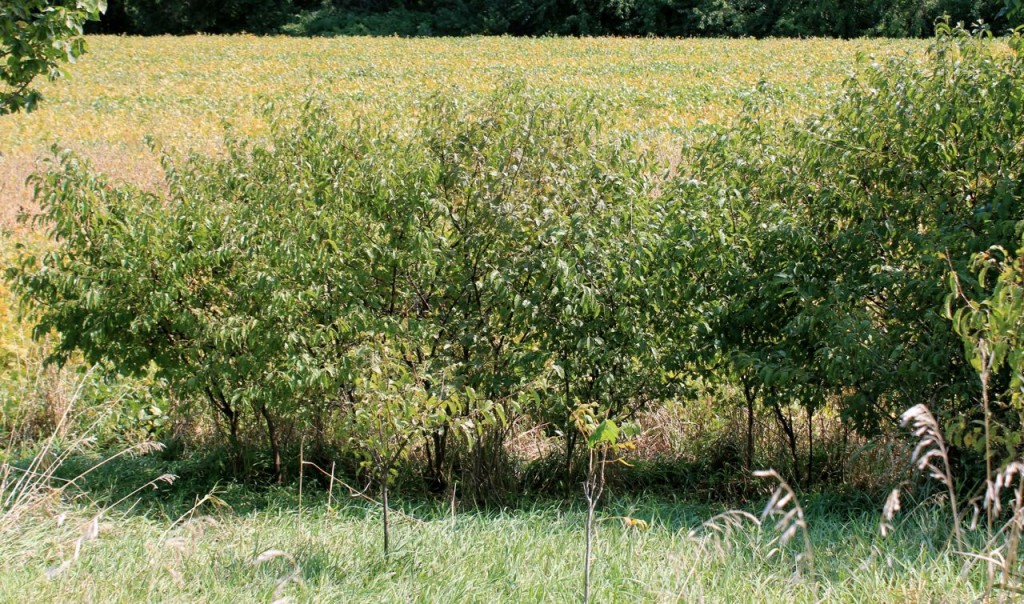
These pretty little yellow plums should have a name: “blushing golden” or “golden blush,” or “prettier than anything” or something. But no.

My latest find: cherry plums! They were a bit difficult to identify at first, since they look like cherries but are firm, like crabapples, but (when ripe) taste like plums.
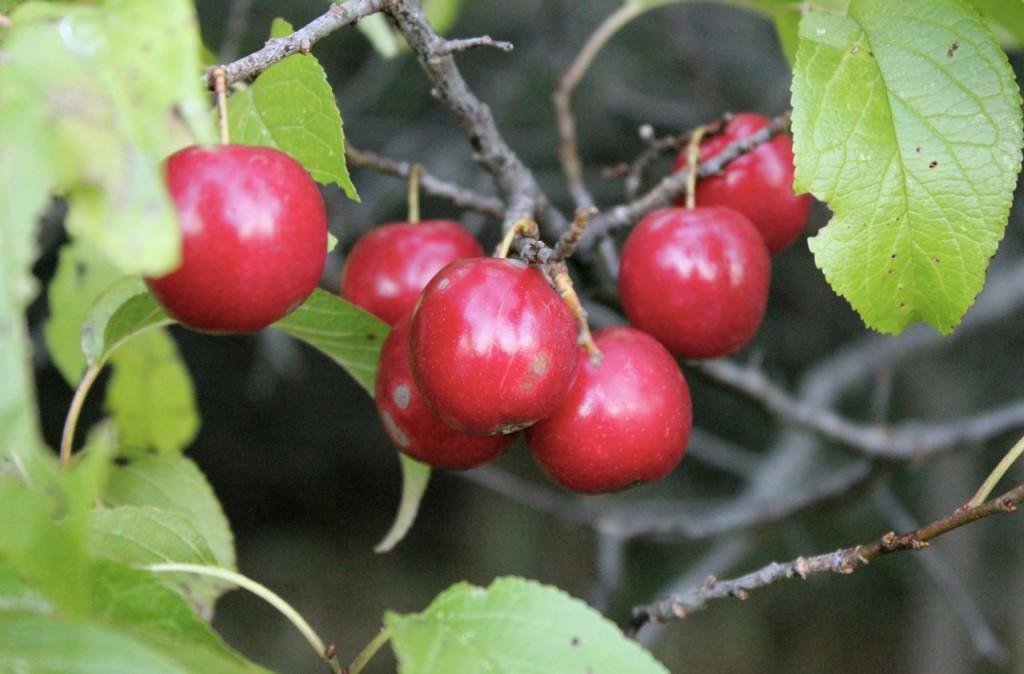
These plums grow on trees that get quite large, and knit together like a hedge. They are used in many parts of the world in hedgerows. The trees we found look old, but aren’t stout enough to climb to get at the fruit at the tops of the trees. So we just had to look–wistfully–at it from the ground.
If only we could fly.
Can you even imagine a prettier hedge than this? I can’t.
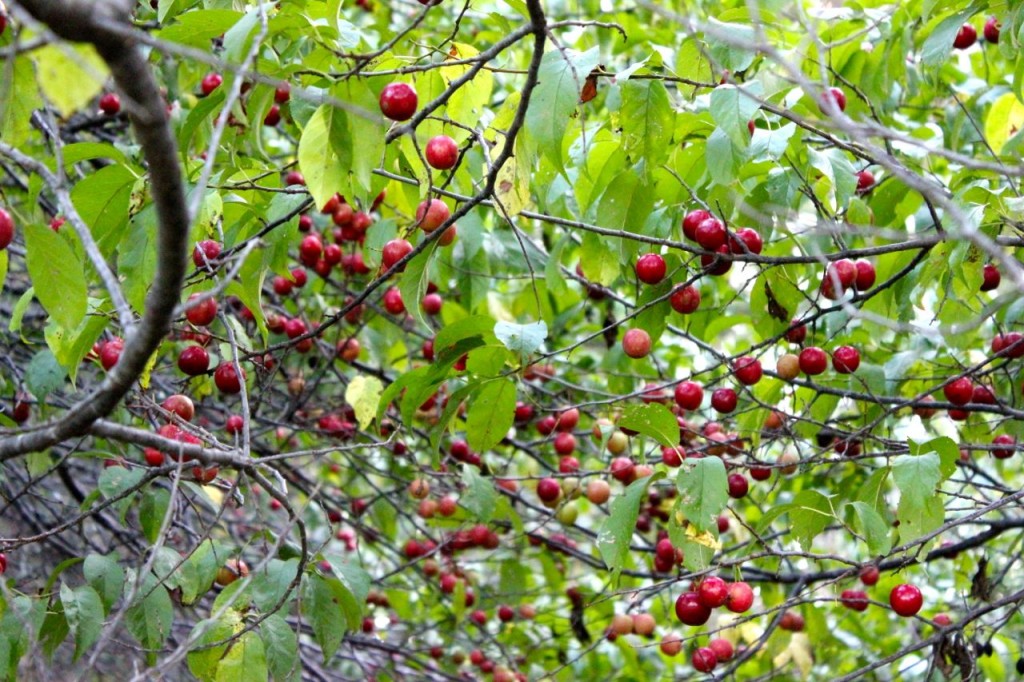
So you can see why I’ve been leaving my house–this time–and enjoying foraging in the woods and ditches for these treasures. It’s pretty intoxicating, finding such lovely edibles. Now I’ve got to decide what to do with it all–I’m thinking of canning plum juice the same way I canned grape juice a couple of years ago, making wild plum jelly, and canning up a few pints of these lovely cherry plums, just for eating.
I’ll let you know how it goes. 🙂
Oh, and hey. I know for a fact that the dust can wait. 🙂 It’s plum patient.
😉
- Long Live Summer! Cherry Tomato and Quinoa salad
- Clueless Blogger Series: How to set up a mailing list with Mailchimp: “ain’t so bad”!


These pictures are just stunning! So beautiful! I am plum tuckered out after hearing of all your harvesting. 😉
Aren’t they pretty, honey? God does know how to design the loveliest things, even when they are largely ignored by us!
Plum picking sounds so fun and they look delicious! We picked peaches this year and I have to say, they were the most delicious we had ever eaten!
I’ll bet they were wonderful, Salma!
We don’t have wild plums so I’ve planted three varieties in the orchard. It will be a few years before they start producing, and I am anything but patient about it. I’m envious of your bounty!
Oh, Robin, no wild plums? That leaves me speechless. We have so MANY I’d be happy to share with you. But I’d love to know what varieties you found to plant!
Pingback: Week 8 — 365 Challenge | Second Breakfast
You brought back memories of over 35 years ago, when my husband and I lived in Wichita, Kansas. We were introduced to sand plums. Someone shared a picking spot with us and, one July, we were able to pick and make sand plum jelly. We planted the pits. But the next year, we moved. We have no idea if those plums ever flourished in the sandy soil of our former back yard. And, there’s no such thing as sand plums (as far as I know) here in upstate New York.
Alana, are there wild plums at all? I’m curious if there is as much wild food in New York state as there is here in Nebraska.